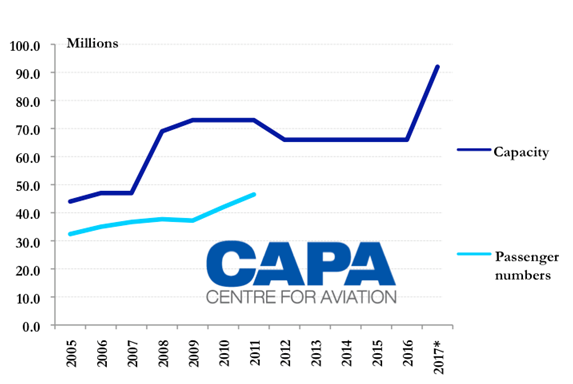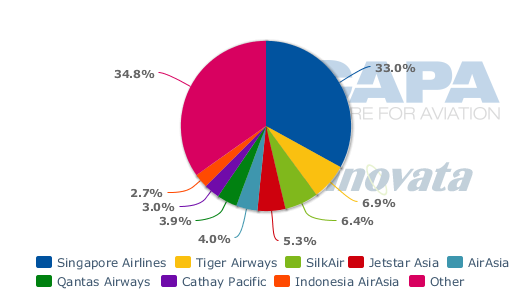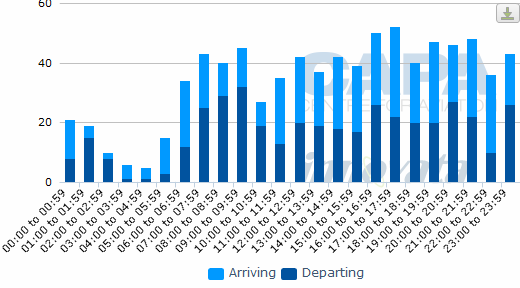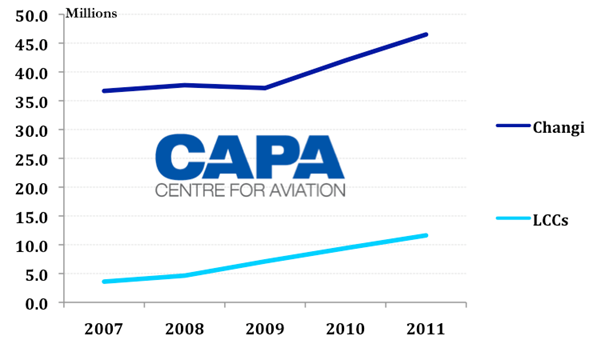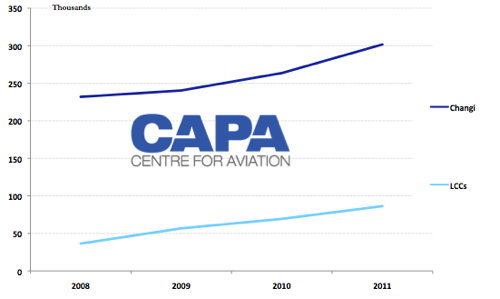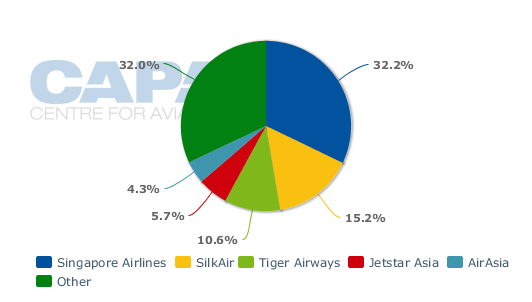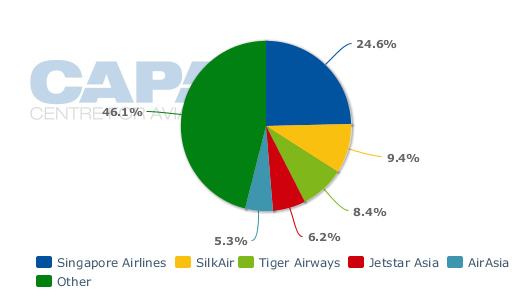Singapore Changi’s decision to close budget terminal could backfire as need for third runway grows
Singapore Changi Airport has taken the unusual decision to demolish its relatively new low-cost carrier terminal and build a larger hybrid terminal in its place. The closure of Changi's Budget Terminal in Sep-2012 will result in the airport's total handling capability shrinking by 10% during what could prove to be a challenging four-year period before the new hybrid Terminal 4 opens. Singapore also faces a pressing need to decide on the opening of Changi's third runway, which is now only available to military aircraft, if it wants to stay ahead of the growth curve. Growing LCC operations have seen aircraft movements grow higher than passenger numbers.
A third runway and even a fifth terminal will eventually be needed for Singapore to maintain its status as a leading hub. Singapore and Changi have always made the investments to ensure there is plenty of space for growth and first class facilities for passengers. But the highly profitable airport has come under scrutiny over the last year: first for its unusual decision to start charging a tax for transit passengers and now for its decision to close its Budget Terminal only six years after it opened.
- Singapore Changi Airport is demolishing its low-cost carrier terminal and building a larger hybrid terminal in its place.
- The closure of Changi's Budget Terminal will result in a 10% reduction in handling capability until the new Terminal 4 opens in 2017.
- Singapore needs to decide on the opening of Changi's third runway to stay ahead of growth.
- Changi risks a capacity shortfall if annual growth rates continue at the current pace.
- The new Terminal 4 will have more passenger amenities and accommodate widebody aircraft.
- The decision to close the Budget Terminal and implement a transit tax has been controversial.
Changi currently has capacity to handle 73 million passengers p/a. With the Budget Terminal closing, this will drop on 25-Sep-2012 by 7 million passengers p/a to 66 million (although last year the Budget Terminal operated at 66% of capacity, handling 4.6 million). The replacement Terminal 4 will be designed to handle 16 million passengers p/a, boosting total capacity to 82 million passengers by 2017.
T4 will be built without aerobridges but Changi says it will have more "passenger amenities," including a wider selection of retail, food and beverage options than the Budget Terminal it replaces. While this will appeal to passengers, Changi will benefit from increased non-aeronautical revenue, which often comprises the largest source of revenue for airports.
The new terminal is also expected to accommodate widebody aircraft, something the current Budget Terminal cannot support and had become an issue because new Singapore Airlines low-cost long-haul carrier Scoot is interested in an LCC terminal option but will launch operations in the next few months from T2. More details on T4 will be released in the coming months and construction is expected to start next year.
Changi risks capacity shortfall
For an airport that is always well ahead of the growth curve, Changi seems to be cutting it close. Assuming 8% growth p/a, which matches Changi's annual average growth since Singapore's LCC boom began in 2004, Changi will surpass the 66 million passenger mark in 2017 - meaning T4 will open just in time. But if annual growth matches the 12% average rate recorded in the last two years (Changi recorded 13% year-over-year passenger growth in 2010, 11% growth in 2011 and 12% in Jan-2012) Changi would reach 65 million passengers in 2014 and be forced to operate at above capacity levels from early 2015.
At the 12% p/a growth rate, Changi would even reach the post-T4 capacity figure of 82 million in 2016 - just as T4 finally opens. Even based on the 8% p/a rate, a fifth terminal would be needed by the end of this decade as Changi would hit the 80 million passenger mark in 2019.
Singapore Changi Airport annual passenger capacity and traffic: 2005 to 2017*
Singapore Changi Airport 2011 passenger movements and current annual capacity by terminal
|
Terminal |
2011 traffic |
Capacity |
Gates |
Year opened |
|---|---|---|---|---|
| T1 | 16,300,000 |
21,000,000 |
29 |
1981 |
| T2 | 13,000,000 |
23,000,000 |
35 |
1990 |
| T3 | 12,600,000 |
22,000,000 |
28 |
2008 |
| Budget | 4,600,000 |
7,000,000 |
10 |
2006 |
| Total | 46,500,000 |
73,000,000 |
102 |
|
It is not easy projecting the steepness of Changi's future growth curve. Singapore's budget market, which last year accounted for almost 12 million of Changi's 46.5 million passengers, has shown signs in recent months of approaching saturation after seven consecutive years of rapid growth. As Singapore has a population of only 5 million, it is unclear how much additional point-to-point LCC capacity the market can support.
But expansion in the new long-haul end of the low-cost sector, with the upcoming launch of Scoot and rapid growth planned for Jetstar's Singapore-based widebody fleet, should lead to a new wave of LCC growth for Changi. ASEAN open skies in 2015 may also unlock a new wave of growth in the short-haul LCC sector, particularly in the very promising Singapore-Indonesia market.
While Singapore's population is small, there are huge growth opportunities in the country's inbound tourism market as income levels in other ASEAN countries and China increase. Singapore, with its new casinos and shopping malls, has emerged as a leading destination for Asian tourists. Changi may end up regretting its decision to knock out capacity for 7 million passengers p/a as it increases the likelihood of terminal congestion, particularly at peak hours, potentially damaging the appeal of Singapore as a pleasant air hub and as a destination. Conversely, not preparing for future growth - even if it means knocking down and starting again - could have far bigger and longer-lasting ramifications.
Changi had the foresight to recognise very early on the huge potential of LCCs in Asia and offer a budget terminal option to promote LCC growth. The decision to construct one of Asia's first LCC terminals was announced in Jul-2004 as part of deal with Singapore-based LCC Tiger Airways, which agreed prior to its launch to be the anchor tenant. Tiger launched services later in 2004 and moved into the Budget Terminal (BT) when the initial SGD45 million building was completed in 2006.
Tiger's rapid growth subsequently persuaded Changi to more than double capacity in the budget terminal from 2.7 million passengers to 7 million passengers p/a. The SGD10 million expansion of Changi's Budget Terminal opened in 2009.
Budget Terminal closure results in shift of 5 million annual passengers to T2
The Budget Terminal, which has 10 contact stands and lacks aerobridges, was designed to be simple, efficient and modular. While built with the flexibility for further expansion, the Budget Terminal will now be torn down after only six years of use, forcing its five tenants to move into the more expensive Terminal 2. As a result, Singapore's fast-expanding budget airline sector will not have a LCC terminal option for about four years and when the new T4 opens the sector will be provided with a likely more expensive hybrid terminal option.
Tiger now accounts for 85% of total capacity at the Budget Terminal, according to Innovata data. Tiger currently bases 20 A320s in Singapore and operates over 20 routes from Changi.
Philippine carrier Cebu Pacific, the only other pure LCC using Changi's Budget Terminal, now accounts for 8% of total capacity at the Budget Terminal. The three other much smaller tenants consist of regional low-cost hybrid carriers: Firefly, Berjaya Air and SEAir. Firefly, a subsidiary of Malaysia Airline (MAS), is the largest of these carriers. Berjaya is an independent turboprop operator from Malaysia while SEAir is a Philippine carrier that primarily operates turboprops on domestic routes but in late 2010 launched a separate international low-cost operation using two A319s leased from Tiger. SEAir's Singapore flights fall under a marketing tie-up with Tiger, which also has been negotiating with SEAir over the last year to acquire a stake in the carrier and form a joint venture.
The five carriers now using the Budget Terminal now account for 9% of Changi's total current capacity, according to Innovata data.
Singapore Changi Airport Budget Terminal users and capacity (seats per week):
05-Mar-2012 to 11-Mar-2012
|
Code |
Airline |
Seats per week |
|---|---|---|
| TR | Tiger Airways |
86,760 |
| 5J | Cebu Pacific |
15,656 |
| FY | Firefly |
10,080 |
| DG | SEAir |
3744 |
| J8 | Berjaya Air |
480 |
| Total |
116,720 |
The throughput of Changi's Budget Terminal has steadily increased since opening and following rapid growth by Tiger last year started to approach capacity during peak periods. In 2010, Changi and Tiger extended their Budget Terminal agreement through Dec-2012. Tiger last year stated it had begun talking with Changi about potentially expanding the Budget Terminal as space was getting tight.
Tiger last week elected against publicly criticising Changi's decision to close the Budget Terminal, stating, "we believe the plans for the new terminal building will dovetail with our own growth strategies, while improving our customers' travel experience". It is unclear what deal Tiger has received to support the temporary move to Terminal 2 and eventual move to Terminal 4, which is slated to open by 2017. Tiger passengers, however, will inevitably have to pay more to use the new T4.
While Tiger itself may have received a good deal from Changi, Tiger passengers will almost certainly be required to pay the higher fees associated with T2. Tiger will also have to deal with the congestion of the main terminals, which could impact turnaround times until the opening of T4, which in theory should support the same turnaround times as the Budget Terminal because both buildings will lack aerobridges.
Tiger passengers will end up having to pay higher tax after closure of Budget Terminal
Changi currently levies SGD28 in taxes and fees on each passenger departing the main terminals while only SGD18 is levied on Budget Terminal passengers. (This includes a combination of a passenger security fee, passenger service fee and Singapore's aviation levy.) Changi is yet to set a rate for T4 but it will likely be closer to the rate charged in T1, T2, and T3 given T4 will have similar amenities. Tiger has always seen the lower tax of the Budget Terminal, which equates to a SGD10 (USD8) savings on the total price of tickets, as well as the quicker turnaround time the simpler Budget Terminal supports, as an advantage over its two main rivals, AirAsia and Jetstar Asia.
The AirAsia and Jetstar groups have always used Terminal 1 at Changi. AirAsia generally is a big proponent of low-cost terminals and is the main tenant for Asia's largest LCC terminal in Kuala Lumpur, which will be replaced next year with a new LCC terminal designed to accommodate up to 45 million passengers p/a. But AirAsia decided against using Changi's budget terminal after Tiger signed on as the anchor customer - seen at the time as a response to simply avoid mimicking Tiger.
Jetstar Asia elected to stay in T1 to be close to its parent Qantas, which also operates from T1. The Jetstar Group has been more inclined to operate from full service terminals; in Kuala Lumpur Jetstar Asia uses the main terminal while Tiger uses the LCC Terminal. Jetstar has, however, been a strong advocate of Australia's Avalon and Gold Coast airports, which only have budget terminals. Jetstar is also pushing Melbourne Tullamarine to have a new budget terminal similar to the one at Avalon or Gold Coast.
The rapid growth in Singapore by the Jetstar and AirAsia groups has given T1, not the Budget Terminal, the distinction of being Singapore's largest terminal for LCCs. Last year over 60% of Changi's LCC traffic was handled in Terminal 1.
About 45% of the 16.3 million passengers that were accommodated in T1 during 2011 came from LCCs. T1 is now the most congested of Changi's terminals, operating at almost 80% of capacity while T2 and T3 are now operating at less than 60% of capacity.
The congestion at T1, particularly during peak hours, is likely to become worse as the terminal hosts some of Changi's fastest growing carriers, including AirAsia, Jetstar and Emirates. T1 will benefit from a SGD500 million upgrade project that will be completed later this year. But while the upgrade gives Changi's original terminal a much needed facelift, no additional capacity will be provided.
Cramped T1 now houses most of Changi's low-cost carriers
Currently, seven of Changi's nine largest LCCs now operate from T1. This includes Indonesia's Lion Air, three LCCs from the Jetstar Group - Jetstar Asia, Jetstar Airways (Australia) and Valuair - and three LCCs from the AirAsia Group - AirAsia Malaysia, Thai AirAsia and Indonesia AirAsia.
AirAsia, when including all three affiliates, accounts for 8.1% of total capacity at Changi, based on Innovata data for the current week. The Jetstar Group (includes all three affiliates) now accounts for 7.4% of total capacity at the airport. This makes Tiger, which now accounts for 6.9% of total capacity at Changi, Singapore's third largest LCC group after Jetstar and AirAsia (although AirAsia, unlike Tiger or Jetstar Asia, does not have a local operating certificate). When including the 3.9% capacity share held by Jetstar parent Qantas, the Qantas/Jetstar group is bigger than AirAsia with a combined 11.3% share.
Singapore Airlines (SIA) and its fully-owned subsidiary, SilkAir, now account for 39.4% of capacity at Changi. SIA also owns a 33% stake in Tiger.
When looking at individual carriers rather than groups, SilkAir is still the second largest carrier at Changi, followed by three LCCs - Tiger, Jetstar Asia and AirAsia (Malaysia). The largest carrier by far at Changi is SIA, although it has seen its market share steadily slip as LCCs have expanded; SIA's traffic has been flat over the last several years while LCCs have grown their traffic at Changi from almost zero to 12 million passengers since 2004. This is primarily the impetus for SIA to launch Scoot.
See related article: SIA's long-haul low-cost subsidiary strategy to restore growth after a lost decade
Singapore Changi Airport capacity share by carrier (% of seats): 05-Mar-2012 to 11-Mar-2012
LCCs now account for 26.5% of total capacity at Changi, which is almost identical to the global LCC penetration rate of 26%. But the rise of Singapore's budget market has been very rapid. In 2003, Singapore had a LCC penetration rate of zero compared to a global LCC penetration rate of about 12%. The rapid growth of LCCs in the Singapore market has almost entirely been driven by the AirAsia, Jetstar and Tiger groups. Singapore is the only market that boasts large operations from all three of these leading Asian LCC groups.
Combined, the AirAsia, Jetstar and Tiger groups account for 85% of LCC capacity at Singapore. Lion and Cebu Pacific account for another 11% with the remaining capacity held by Changi's three smallest LCCs: Air India Express, AirPhil Express and India's IndiGo. This trio of carriers are also the only three LCCs now operating at Terminal 2 (AirPhil Express and Air India Express both selected T2 in order to co-locate with their sister carriers Philippine Airlines and Air India, respectively).
See related article: Singapore-India market poised for rapid growth as IndiGo eyes large operation at Changi
LCCs serving Singapore: 07-Mar-2012
|
Code |
Airline |
Country |
Seats per week |
Terminal |
|---|---|---|---|---|
| TR | Tiger Airways |
86,760 |
Budget |
|
| 3K* | Jetstar Asia |
66,600 |
T1 |
|
| AK^ | AirAsia (Malaysia) |
50,760 |
T1 |
|
| QZ^ | Indonesia AirAsia |
33,840 |
T1 |
|
| JT | Lion Air |
23,474 |
T1 |
|
| FD^ | Thai AirAsia |
17,640 |
T1 |
|
| 5J | Cebu Pacific |
15,656 |
Budget |
|
| JQ* | Jetstar Airways |
13,760 |
T1 |
|
| VF* | Valuair |
12,240 |
T1 |
|
| 6E | IndiGo | India | 5040 |
T2 |
| IX | Air India Express | India | 4158 |
T2 |
| 2P | Airphil Express | Philippines | 2464 |
T2 |
The move later this year to T2 by Tiger and Cebu Pacific will mean almost 40% of Changi's LCC capacity will be operating from T2, up from only 4% currently. (The other three airlines moving from the Budget Terminal to T2 - Firefly, SEAir and Berjaya Air - are not counted as LCCs in the Innovata database.)
Scoot, which is fully owned by SIA, will also operate from T2 when it launches services in June. Rapid expansion by Scoot, which plans to operate at least 14 Boeing 777s within four years, and continued expansion at Tiger could quickly lead to congestion at T2. The terminal operated at 57% capacity in 2011 but will be operating at above 80% capacity by the end of this year.
Assuming growth of 10% p/a, T2 will be operating above capacity in 2014, or two to three years before the opening of T4. SIA, however, could potentially move some or all of its T2 flights to T3, which last year was operating at 57% capacity and will be by far the most underused terminal at Changi once the Budget Terminal tenants move to T2.
SIA now splits its operation between T2 and T3 while SilkAir only operates from T2. All of SIA's mainline flights could potentially fit into T3, which has capacity for 22 million passengers p/a and is the newest of Changi's terminals having been completed in 2008 at a cost of SGD1.75 billion. But some of the current T3 tenants may have to shift to T2 if SIA moved its entire operation to T3.
Rapid LCC growth at Changi has led to the need for a third runway
The most pressing issue at Changi, however, may be runway rather than terminal congestion. Over the last several years, LCCs have accounted for almost all the growth at Changi Airport. As LCCs primarily operate narrowbody aircraft, this has led to higher growth in aircraft movements than passenger movements. As a result, taxi times have increased steadily and it is now common during peak periods for aircraft to queue for takeoff at Changi for over 30 minutes.
There are now at least 40 hourly movements at Changi from early morning to late at night with the only exception of a brief quiet period in the late morning. The biggest peak is in the late afternoon and early evening, when there are 50 or more hourly commercial aircraft movements scheduled.
Singapore Changi Airport commercial aircraft movements per hour: Mar-2012
In 2011, commercial aircraft movements were up by 15% at Changi while passenger movements were up by 11%. Faster growth in movements than passengers has been the trend at Changi since 2007, when LCCs accounted for only 10% of total passengers. LCCs accounted for 29% of commercial aircraft movements and 25% of total passengers in 2011.
Singapore Changi Airport total passenger numbers vs LCC passenger numbers: 2007 to 2011
Singapore Changi Airport commercial aircraft movements vs LCC aircraft movements: 2008 to 2011
From 2007 to 2011, commercial aircraft movements at Changi shot up by 30% from 231,900 to 301,700. During the same four-year period, passenger movements increased by a more modest 23% from 37.7 million to 46.5 million. As a result, the average number of passengers per commercial aircraft movement has decreased from 163 to 154. This is not a perfect measurement as freighter movements are included in these figures but it illustrates the general drop in average aircraft gauge at Changi as LCCs have expanded rapidly, leading to the current runway congestion challenge.
The rapid growth of LCCs is clearly behind this trend. Narrowbody carriers have accounted for almost all of the growth at Changi in both movements and total passengers since 2004, when Singapore's budget carrier boom began with the launch of Tiger and Jetstar Asia.
From 2004 to 2011, total annual traffic at Changi increased by about 16 million passengers. LCCs accounted for about three-quarters of this growth, or 12 million passengers. All-narrowbody operator SilkAir has also grown its annual passenger traffic by two million passengers over this period. Other full service carriers, a mix of narrowbody and widebody operators (Gulf carriers in particular), have grown their traffic at Changi by roughly three million passengers during this period while all-widebody operator Singapore Airlines has seen its annual traffic decrease slightly, by about one million passengers per year.
When measuring movements, there is a similar picture. LCCs have accounted for almost three-quarters of the increase in commercial aircraft movements since 2004 while SilkAir has accounted for roughly another 10%.
SilkAir now accounts for 15% of peak hour movements at Changi while Tiger accounts for 11%. During off-peak times SilkAir accounts for 9% of movements and Tiger 8%.
Singapore Changi Airport share (%) peak time aircraft movements by carrier: 05-Mar-2011 to 11-Mar-2011
Singapore Changi Airport share (%) off-peak time aircraft movements by carrier: 05-Mar-2011 to 11-Mar-2011
Over the next several years the rise of low-cost long-haul carriers could lead to a slight de-acceleration of this trend. There are currently only three widebody LCC flights per day at Changi, but this will increase exponentially as Scoot launches and as Jetstar adds a Singapore-based A330s and later Singapore-based 787s.
See related articles:
- SIA's new long-haul LCC to start with 400-seat 777s, plans 16-aircraft fleet in four years
- Jetstar plans Singapore expansion with new North Asia focus
However, the number of widebody LCC movements will be relatively small and will likely not offset further growth in narrowbody movements. The overall trend towards smaller gauge aircraft will likely continue as Tiger, AirAsia and SilkAir continue to expand and as Jetstar adds A320s, likely at a faster rate than widebodies.
Most of Changi's biggest growth markets are now within ASEAN, and in particular Indonesia, Malaysia and the Philippines. With the exception of some SIA-operated flights, which are generally not expanding, these markets are now predominately served by narrowbody aircraft from both full service and low-cost carriers.
For example, there are now five Indonesian carriers offering a combined 90,000 seats per week to and from Singapore, but not a single one of these flights is operated with a widebody aircraft. Indonesia is the biggest single market from Singapore and is poised for massive predominately narrowbody growth as Indonesia's LCCs rapidly expand and as ASEAN open skies is implemented in 2015.
See related article:
- Garuda Indonesia, Citilink and Lion accelerate fleet expansion
- Tiger places big bet on Indonesia with re-launch of Mandala
Changi needs to make third runway decision soon
While Changi has been proactive at adding terminal capacity (with the opening of the budget terminal in 2006 and Terminal 3 in 2008) to keep up with overall passenger growth, it has not yet added any runway capacity to keep up with the even faster growth in movements. Singapore needs to make a decision on opening up to commercial aircraft the third runway at Changi, which is now only used by military aircraft and belongs to the Changi airbase, to reduce the current runway congestion and provide sufficient runway capacity for future growth.
The third runway, located to the east, is currently separated from the commercial airport and is not linked to the existing two runways. But the third runway could potentially be accessed through a new fifth terminal. Given the relative isolation of the east side of Changi, it would be logical for such a terminal to be a budget terminal and accommodate at least some of Changi's LCCs.
Connectivity could be an issue as increasingly LCCs are pursuing codeshares and interlines with full service carriers; one recent one is between Jet Airways and Jetstar.
See related article: Jet Airways-Jetstar interline positions carriers for growth in India, Southeast Asia and Australasia
Even LCCs which do not actively promote connections benefit increasingly from self-connections. For example, since Tiger and Scoot will be co-located at T2 from September, they both stand to benefit from self-connections, although they are not pursuing for now a formal tie-up. Tiger Airways earlier indicated the lack of co-located facilities between Tiger and Scoot was a factor in their decision to not pursue a tie-up, but since that will no longer be a problem the relationship between the two may now be re-evaluated.
Connectivity issues with the potential fifth terminal on the east side of Changi, however, can be overcome through rail or road links. If Changi elects to build a new terminal on the east side, connections can be potentially offered via a tunnel connecting the two sides of the airport. A new airside link is also expected for T4, although Changi has not yet provided details (the current Budget Terminal only has a landside bus link).
There is always a way to offer connectivity although sometimes it comes with a hefty price tag. For example, a link is now planned between Kuala Lumpur's new LCC terminal and the main terminal. This link will help facilitate connections between AirAsia and MAS, which are now pursuing a partnership following their historic share swap of Aug-2011.
The opening of the third runway at Changi is a matter of if rather than when. A rapid decision, however, would give Changi more options. For example, Changi would have the flexibility to build T4 (either as a new bare bones budget terminal or hybrid terminal as now envisioned) on the east side rather than have to demolish the current Budget Terminal to make room for T4. This would allow Changi to reverse plans to close the Budget Terminal later this year and instead keep it open until T4 was completed, saving it from the crunch it now faces as total terminal capacity reduces during the interim four-year period. The Budget Terminal would not have to be demolished until 2017, at which point Terminal 5 could be constructed in its place. Regardless, a fifth terminal will likely be required by early next decade.
Budget Terminal decision follows controversial implementation of new transit tax
The decision to close the Budget Terminal is the second controversial decision made by Changi in less than a year. In mid-2011, Changi implemented a new SGD8 (USD6) tax on transit passengers. Changi is the first airport in the region to charge a tax on transit passengers. It is very unusual for transit passengers to be taxed by an airport. One other recent example is Panama's Tocumen Airport, which implemented a small transit tax earlier this year, a move which was also unpopular among carriers.
See related article: New tax on transit passengers can lead to slower growth at Panama's Tocumen Airport and Copa
The new transit tax puts Changi and its carriers at a possible competitive disadvantage for transfer traffic, in particular for long-haul passengers transferring to other Asian points as well as Australia. Other airports competing for Asian and Australian transfer traffic do not have such a tax. Emirates and Qantas, both of which use Changi as a transit point, lobbied against the tax and tried to argue it should at least not apply for passengers flying through Changi on single flight numbers. But such an exemption would have been unfair to Singapore Airlines, which competes against Emirates and Qantas on the kangaroo route and relies on transit passengers for roughly half of its Changi traffic. In the end, the tax was implemented for all transit passengers despite resistance from some carriers.
Changi is already a highly profitable airport operator, posting a profit after tax of SGD337 million in the fiscal year ending 31-Mar-2011 on SGD1.454 billion in revenues. Fees and charges accounted for 37% of Changi's revenues in FY2010/11 while concessions accounted for 42%. Airlines have long tried to persuade airports to rely on concessions for a higher portion for revenues and airlines have complained that airports abuse their monopoly power to post margins that are significantly higher than the airline industry's single-digit margin. Changi's net margin was 23% in FY2010/11 while its EBITDA margin was 42%.
While the need to charge a transit tax seems unnecessary, the amenities that Changi offers - many of which are targeted specifically for transit passengers - are undeniably world class. It would also be unfair to criticise Changi for the recent decision to close the Budget Terminal. The decision to open the third runway and the east side of Changi, which would have given Changi Airport another site for building T4, is a government decision. Changi simply has to wait until the Government believes it is the right time to proceed. In the end, the Singapore Government values the country's status as an air hub and will do what is needed to be competitive and promote further grow.
Rival Hong Kong, which also currently has two runways, decided last year to pursue construction of a third runway. Hong Kong International Airport is now only about one year ahead of Changi on the growth curve, having accommodated 53.9 million passengers in 2011 (16% more than Changi) and 333,760 movements (11% more than Changi), which is the more critical measure when it comes to determining the need for an additional runway. Hong Kong has recognised it will need a third runway to stay competitive as a leading hub. It is inevitable Singapore will come to the same decision.
